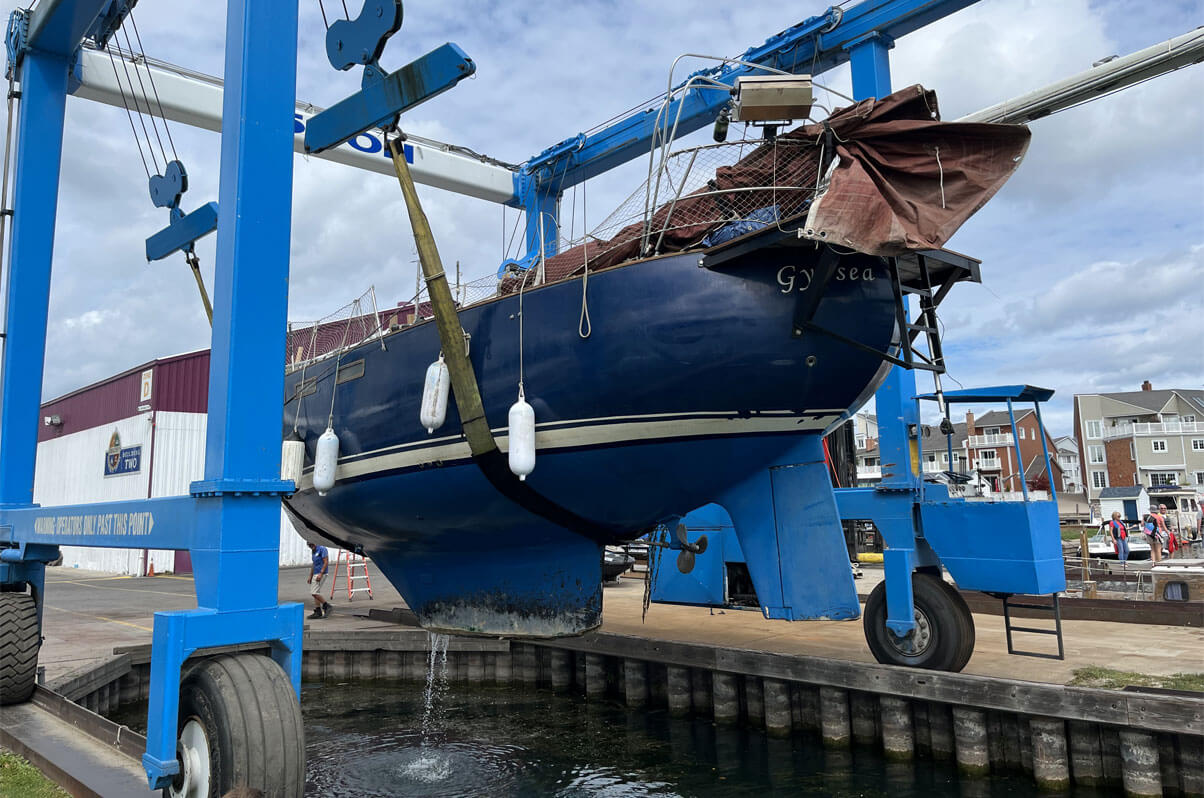
As a certified captain for C-Tow, one of my most memorable rescues took place in early September 2022. My jurisdiction for C-Tow is the Kawarthas, specifically the Tri-Lakes area in South Central Ontario. However, on an early Friday morning, C-Tow dispatch contacted me explaining a 44’ sailboat at Kettle Point near Grand Bend on Lake Huron was jammed on a rocky shoal, was taking on water and required a tow to a safe haven.
After getting more details, I loaded my 24’ Stanley on a trailer and gathered all of my necessary marine gear. Given the size of the vessel, I asked a colleague for assistance with his Chris Craft cuddy. He willingly obliged and made the 300-plus km trip to the southwestern shore of Lake Huron. Meeting the boat owner on land in Grand Bend mid-afternoon, he explained he navigated too close to shore and hit a rocky shoal head-on. He and his partner then jumped ship and swam the short distance to shore since their tender was damaged.
When we arrived at his vessel, the boat’s keel and part of the skeg were indeed jammed right in the rocks. It was also taking on water due to a deep tear in the bottom from the impact. Towing a 20,000-pound sailboat is one task. Getting it off the rocks without further damage is certainly another. After running the pump to gain more buoyancy; rigging up the proper bridals/lines at the best tow points; and cruising to deeper water, our two rescue boats got the vessel free without any issues. Unfortunately, after towing it 200 to 300 meters, it got hung up on the rocks again and swung 180 degrees from the impact. So, I had to reset the tow lines and also find deeper water to effectively free the vessel. All the while, the pump was working overtime to prevent it from sinking.
My colleague and I got the vessel off the rocks once again (without any damage), but not before darkness fell, the wind had picked up and water conditions became very rough. While I was towing the vessel with my Stanley, my colleague was tied off in his Chris Craft off the vessel’s portside to ensure the pump was working and that the boat remained on course. Fortunately, we continued towing until we arrived at the closest marina in Grand Bend. By this time, it was 1:00 a.m. Given the challenging conditions in the dead of night, the size of the vessel and the tight confines of the marina, we contacted a local C-Tow captain for help. With the support of a number of Zodiacs and successful rescue initiatives, everything worked perfectly and the vessel was maneuvered and soon tied up at the marina’s main dock. I then contacted a transport company to deliver the vessel back to its home port. By this time, it was 4:30 a.m. After nearly a 20-hour push, we arrived back in the Kawarthas around 9:00 a.m., relieved the worst was over and the vessel was safe and secure.
To my surprise, Andy called me at approximately 2:00 p.m., explaining the same boat required another tow. Since the marina’s boat launch couldn’t accommodate the transport company’s large oversized trailer and the cost to hire a specific crane to lift it out was too expensive, the owner kindly requested a tow to a full-service marina with the proper facilities. Early the next morning, after arriving back in Grand Bend, we learned that the only marina that would accommodate the vessel was eight hours (by boat) away in Sarnia, ON, meaning we had to navigate through commercial shipping channels. After setting out in calm conditions, the wind and waves kicked up in the early afternoon, all the while towing among commercial freighter traffic, a swift current and deep swells.
The wind is always challenging, but it’s three times as difficult when towing a boat that doesn’t have power or control. Once we made it to the marina, I safely towed the vessel through the entrance and then used the push pads on my Stanley to maneuver it to the pre-designated area near the travel lift. By late afternoon – and almost 48 hours since the initial rescue call – the vessel was successfully lifted to shore. Once on land, we saw the whole keel was torn from stem to stern with damage to the skeg and other hull components. But it was the efforts of continuously running the pumps and applying successful ‘by-the-book’ towing practices that prevented the boat from its ultimate fate. By the time we left Sarnia, a transport trailer was finally on route to deliver the vessel back to its home port for repair.
